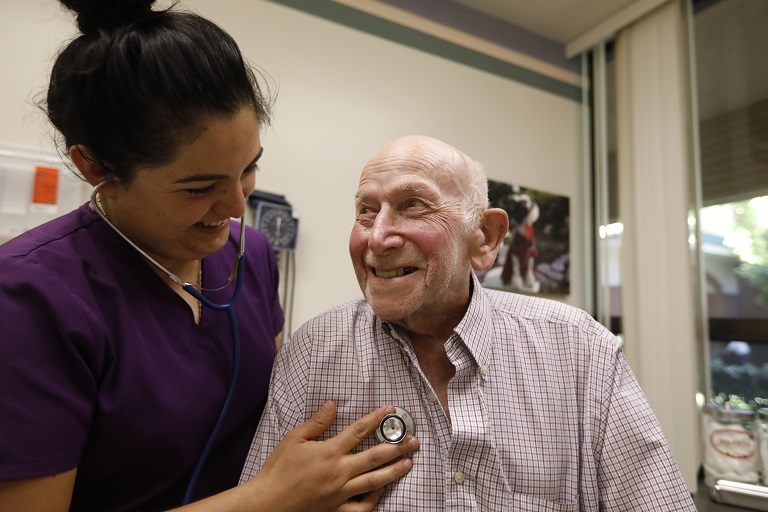Interview with Dr Nimalie Stone
Q: We are pleased to have you return to our call. Things seem to have taken a turn for the better since we last spoke. How promising are the numbers and are we really at a good point with cases and hospitalizations?
A: I am excited to see where we have come in this roller coaster ride we have been on. We have seen some big paradigm shifts in how we are living with Sars cov2 virus. We are seeing the cases among nursing home residents decline – now at 5 per 1,000 resident week down from 40 in January. We are also seeing the reduction among staff members, and it speaks to the tools we have to protect ourselves. Over 87% of the staff and residents in nursing homes are fully vaccinated and 70% of residents and many staff members have gotten boosters.
Q: We are seeing a quick change in COVID-19 restrictions and CDC guidance. Do you think that we are re-opening things too quickly and do we still need to be vigilant?
A: It is important that people are getting the information they need to understand the change in how we are measuring impact. Covid 19 community levels are being used and they measure different information. We had been tracking case rates to judge what prevention strategies we needed to take. We have been in high/ red community transmission levels for months related to the highly transmissible omicron variant. However, the measures of spread can’t tell us how severe the illnesses are. We need to know whether most people are having mild illness or are we seeing many people admitted to the hospital and having bad outcomes. We can look at the burden on our communities by asking how individuals with infection are being affected and how our health systems are faring – to care not only for people with COVID but also people with other health care needs. The new measures are looking at the significant impacts from the virus on people’s health and the strain on the healthcare system. We are continuing to track how many new cases are being reported, and we are also using that to adjust community levels.
Q: We saw many hospitals under great strain. Are we seeing reductions in that?
A: Right now, a large portion of counties are in the low level. So that does indicate that hospital capacity in many communities is quite good.
Q: What would you say to those older adult communities that have an open campus, where visitors and residents can easily enter the health care settings? Which guidance should such a campus follow: community levels, or community transmission?
A: With this move toward community levels, it is important to remember that even if my community level is low and there is an opportunity to not wear masks, that doesn’t take away people’s personal decisions. If people feel more comfortable wearing masks that should be supported. In settings where people have higher risks, we may temper some of our changes to make sure everyone around us feels comfortable and can get together safely. There is more personal choice, and we are hoping people can think through things like vaccination status and level of personal health risk, as well as using home-based tests.
Q: Would you recommend that Life Plan Communities/ CCRCs follow these same “community level prevention strategies” at “medium” and “high” community levels?
A: Right now. for healthcare settings we have not yet shifted to community levels- so healthcare settings still need to follow community transmission levels and observe greater precautions. We get questions about whether assisted living and independent living communities should follow healthcare guidance. It is difficult to give a yes or no answer. Many older people are at risk, but there is also a need for some relief. We are going to have to learn together about what the right balance is. My thinking is that in communities with low levels we could ease up a bit on masking and so forth. There are conversations at the CDC about this. If we are moving to higher levels then it is important to look at who the residents are and how at risk they are. It might mean doing a hybrid approach – for example, using face masks for hands- on care but not so much otherwise. Of course, if it becomes a high burden of transmission or levels, then we need to go back to more strict precautions.
Q: What are your thoughts on the testing of visitors to older adult communities that are not considered healthcare settings?
A: We have, even in healthcare, not had a strong expectation that visitors are required to be tested. But we have encouraged people to use home tests and think about whether they are going to see someone who is vulnerable. We hope people are using these – particularly if community levels are going up.
Q: You mentioned the tools we have in our toolkit – are cloth masks still effective or should everyone be wearing N95s and KN95s?
A: We put some additional information on the CDC website about different types of masks and it created a perception that what we had been doing previously was totally unsafe. Frankly, the best mask is one that people will use and fits them well. For some people, that might be a good cloth mask. Some N95 and KN95 respirators are not comfortable, and people take them off or fiddle with them. There are clearly different levels of filtration and N95s and KN95s have better filtration, but people will get some levels of protection with any mask they will wear.
Q: When we look at the new metrics for community levels are hospital staffing shortages included in the metrics?
A: The way the levels are tracked is by the number of staffed and occupied beds. I may shut unit because I don’t have staff, but my reporting is about the beds that are staffed. Hopefully that will take into account staffing concerns, but we are hearing more about staffing issues from local health departments and we will be looking into that further.

Most Recommended
October 15, 2025
 Shutdown Week Three: Impact of Ongoing Closure on Affordable Housing
Shutdown Week Three: Impact of Ongoing Closure on Affordable Housing
December 10, 2025
Fiscal Year (FY) Funding 2026
October 07, 2025
Immigrant Workforce Matching Program Brings Workforce Relief
Recently Added
December 19, 2025
House Moves Forward on Affordable Housing Reforms
December 19, 2025
White House Cannabis EO Paves Way for Research, Access
December 19, 2025
LeadingAge Urges DHS to Maintain "Public Charge" Guardrails
December 18, 2025



